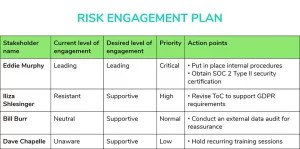24 October 2023 • Cyber security

95% of all hacks and data leaks are caused by human errors, such as:
- Clicking on a phishing link
- Not regularly updating software
- Working on public Wi-Fi without a VPN
- Using weak passwords
Most of these human errors can be prevented by improving the state of cyber security awareness within your organization.
In this article, you’ll learn the basics of security awareness and how your organization can start improving it today.
What is security awareness: a definition
Security awareness refers to an understanding of cyber threats and best practices for safeguarding sensitive information and systems. It involves recognizing potential risks, adhering to secure behaviors, and staying informed about evolving cyber threats to protect against data breaches, malware, and other online security challenges.
Why security awareness is more important than ever
There are a lot of misconceptions about security awareness. Here are a few we hear a lot:
→ “Security is the responsibility of the IT department, not mine”
→ “Cyber criminals are too advanced for security awareness training to be effective”
→ “Cyber criminals only hack huge corporations, why would they target me?”
→ “My employees don’t need training, they’re experienced internet users”
As stated in the intro of this article, 95% of all hacks and data leaks are caused by human error. No matter how much cyber security software you have in place, it can’t protect you from human mistakes such as clicking a phishing link or using weak passwords. This means that every single employee within your organization carries the responsibility to keep your company data safe.
Many of the tactics that cyber criminals use are not as advanced as people think. Once your team is aware of the basics, the chances of a data breach decrease by a lot. For instance, most data leaks are still caused by weak passwords and the absence of two-factor authentication.
Here is an example of an ethical hacker hacking an organization’s system. Not with fancy tooling, but with simple social engineering:
If your organization is aware of these threats and has the right procedures in place, examples of hacks like this are way less likely to occur.
Most big corporations have invested thoroughly in cyber security. That’s why cyber criminals are widening their scope and targeting companies of any size. In 2022, cyber attacks on small businesses were more frequent than attacks on larger companies. In the same year, there was an overall increase in global cyber attacks of 22%.
All the above means that it’s a must for companies of all sizes to invest in security awareness for their entire organization.
How to develop security awareness within an organization
To develop a strong security awareness program within your organization, you’ll need to take the following steps.
Get buy-in from leadership
Before you start any security awareness campaigns, make sure to get support from your leadership team. If leadership is not invested, all your hard work will be for nothing in the end. If your CEO doesn’t care, why should the rest of the company feel invested?
Share the importance of security awareness (or simply share this article 😉 ) and create a regular cadence in which you update them on ongoing security projects.
Once your leadership team truly believes in the necessity of cyber security awareness, you can start focusing on the so-called departmental champions. These are often team leads who are closer to the rest of the company and may need to help you carry out security initiatives. They are the people through which you communicate concerns and new security measures.
If you work in a larger organization and you need to convince a lot of stakeholders, it can be helpful to keep track of them in a stakeholder management template.
When presenting your plans to the leadership team, it’s important to make clear that this is a long term program. If this is not clear, some people may think you’ll organize a one-off event. But your awareness program needs to be a marathon, not a sprint, to be effective.
Set up clear policies and procedures
Security policies and procedures are the bedrock of any organization’s defense against cyber attacks. These policies serve as a set of guidelines that not only define how to protect data, systems, and networks but also dictate how employees should behave in the digital world.
Two examples of essential security policies are:
- Data access control policy: This policy outlines who can access sensitive data and under what circumstances. It defines user roles and permissions, access authentication methods, and restrictions on data sharing. This prevents unauthorized people from viewing and modifying confidential information.
- Password policy: A robust password policy establishes guidelines for creating and managing passwords. It dictates criteria for password complexity, expiration, and protection. This reduces the risk of unauthorized account access.
You also need clear procedures for how employees should act when faced with a cyber threat or even a breach.
Set up recurring employee training
Once you’ve got buy-in from the leadership team, it’s time to set up awareness training for everybody within the organization. During these trainings, employees should learn about all relevant cyber threats, which we’ll go through later in this article.
When looking for a training solution, consider the following aspects:
- Pick a training solution that is based on gamification. A security awareness game like Guardey enables users to learn actively.
- Offer training that is recurring. Companies often offer yearly training that gives a quick knowledge boost but doesn’t result in lasting behavior change. Look for training solutions that offer weekly, bite-sized training.
- Make sure that you offer training on all current cyber threats. For instance, if a training solution has no content about the threats of AI, it’s not the right solution. Cyber criminals are moving fast, which means your training solution should develop just as fast to keep your employees in the know.
Frame your program with a positive tone
There is often a negative tone attached to communication surrounding cyber security. When employees fail a phishing test or don’t get high scores during awareness training, they may feel like they’ll get judged or even punished for it. That’s why it’s key to position your program as something that benefits both your organization and the employee.
With that in mind, also understand that people will not care about your security program the same way that you do. Communicating the why can therefore truly make a big difference. Paint a vivid picture of what the impact can be when there is no security awareness program.
Which cyber threats should be included in training?
Security awareness entails more than just phishing and password management. When training your personnel, you need to make sure that you cover every cyber threat that you may face. Here is a far-from-complete list that gives you an idea of threats you that should be included in training.
- Phishing attacks: Teach your team to recognize phishing emails and suspicious links, and emphasize the importance of not sharing sensitive information with unknown sources.
- Ransomware: Provide guidance on identifying potential ransomware threats and stress the importance of regularly backing up data.
- Social engineering: Train employees to be cautious about sharing sensitive information in person, over the phone, or online, and to verify the identity of people requesting confidential data.
- Password security: Promote strong password practices, including using complex and unique passwords, enabling two-factor authentication, and avoiding password sharing.
- Malware: Educate employees about the risks of downloading software or files from untrusted sources and the importance of using reputable antivirus software.
- Insider threats: Create awareness about the potential for malicious actions by employees or partners, emphasizing the need for a culture of both vigilance and trust.
- BYOD (Bring Your Own Device) risks: Provide guidelines for securely using personal devices in the workplace and recognizing the potential security threats associated with them.
- Data handling and protection: Instruct employees on how to properly handle, store, and transmit sensitive data to prevent data breaches and unauthorized access.
- Wi-Fi security: Educate employees on the dangers of using unsecured public Wi-Fi networks and the importance of using a virtual private network (VPN) when necessary.
- Email security: Highlight email best practices, such as verifying email senders, not opening attachments or clicking on links in suspicious emails, and reporting phishing attempts.
And the list goes on and on. If a security awareness training solution doesn’t cover a few of the above topics, consider it incomplete and not the right fit.
The bottom line
Contrary to popular belief, you can in fact outsmart hackers. Security aware organizations are simply less likely to be hurt by cyber attacks. The most hacks and data leaks still happen due to simple human errors: clicking phishing links, working from an unsecured network, or not using two-factor authentication.
To establish cyber security awareness within your organization, you should consider offering regular security awareness training. This enables your employees to learn about the biggest cyber risks and act accordingly when faced with one.
With Guardey’s security awareness game, your team gets a weekly 3-minute challenge about a specific security topic. The game is put together in collaboration with ethical hackers and educationalists to accomplish lasting behavior change. You can now start a 14-day free trial.





